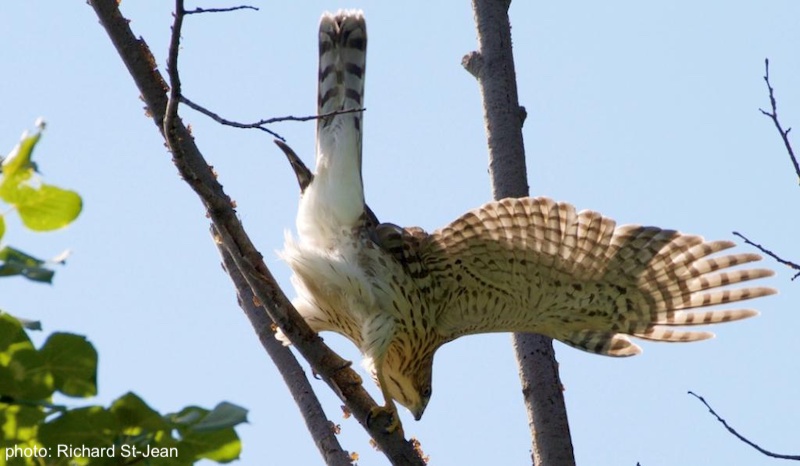A Bird’s-Eye View of Mount Royal
- May 02, 2019
Their songs inspire us and their plumage fires our imagination. Birds have long been a subject of fascination for those of us who delight in looking to the treetops and skies in search of the winged species. Now that spring is finally adding a touch of green to the mountain, Project FeederWatch provides us with information about the birds that visit the feeders of Mount Royal Park in the winter, thanks to the precious help of our volunteers.

FeederWatch: Counting Winter Birds across North America
Launched in 1987, Project FeederWatch is a weekly survey of winter birds that visit feeders all across North America. All with the help of volunteers! In total, over 20,000 volunteers of all ages and backgrounds participate every year, monitoring thousands of feeders and over 100 bird species. Thanks to these observations, this project helps scientists better understand the distribution and abundance of bird populations in North America from November to April.
Birds That Don’t Get Cold Feet
Birdwatching has long been a favourite activity on Mount Royal, even in winter. Although several species leave the mountain once the cold weather settles in, certain birds from the boreal forest and tundra fly south to spend winter here with us. These include the house finch, common redpoll, white-winged crossbill, pine grosbeak and bohemian waxwing. Other species live year-round on Mount Royal such as the white-breasted nuthatch and black-capped chickadee, a small hyperactive bird of just 10 g which is highly visible on the mountain in the winter despite the freezing cold.
Where to Eat in the Park: The Feeder Circuit
Project FeederWatch began in Mount Royal Park during the 2005-2006 winter with the creation of a seven-feeder circuit along Olmsted Path. At the time, the park only had three tray feeders to the delight of the local squirrels.
Les amis de la montagne called on volunteers wishing to get involved in counting birds from November to April, and the response was overwhelming! Since then, 321 volunteers have performed 1,604 counts at the park’s feeders. In all, 16,503 birds of 36 different species have been counted.
This year, 30 volunteers took part in 129 counts, for a total of 1,255 birds of 16 different species. This resulted in 250 hours of volunteering, no small feat!
What conclusions can we draw from Project FeederWatch?
Based on data collected by FeederWatchers across North America, scientists involved in the project were able to observe interesting trends such as:
Bird Species Frequently Observed on Mount Royal Each Year Since 2005-2006
Project FeederWatch
Back 
FeederWatch: Counting Winter Birds across North America
Launched in 1987, Project FeederWatch is a weekly survey of winter birds that visit feeders all across North America. All with the help of volunteers! In total, over 20,000 volunteers of all ages and backgrounds participate every year, monitoring thousands of feeders and over 100 bird species. Thanks to these observations, this project helps scientists better understand the distribution and abundance of bird populations in North America from November to April.
Birds That Don’t Get Cold Feet
Birdwatching has long been a favourite activity on Mount Royal, even in winter. Although several species leave the mountain once the cold weather settles in, certain birds from the boreal forest and tundra fly south to spend winter here with us. These include the house finch, common redpoll, white-winged crossbill, pine grosbeak and bohemian waxwing. Other species live year-round on Mount Royal such as the white-breasted nuthatch and black-capped chickadee, a small hyperactive bird of just 10 g which is highly visible on the mountain in the winter despite the freezing cold.
Where to Eat in the Park: The Feeder Circuit
Project FeederWatch began in Mount Royal Park during the 2005-2006 winter with the creation of a seven-feeder circuit along Olmsted Path. At the time, the park only had three tray feeders to the delight of the local squirrels.
Les amis de la montagne called on volunteers wishing to get involved in counting birds from November to April, and the response was overwhelming! Since then, 321 volunteers have performed 1,604 counts at the park’s feeders. In all, 16,503 birds of 36 different species have been counted.
This year, 30 volunteers took part in 129 counts, for a total of 1,255 birds of 16 different species. This resulted in 250 hours of volunteering, no small feat!
What conclusions can we draw from Project FeederWatch?
Based on data collected by FeederWatchers across North America, scientists involved in the project were able to observe interesting trends such as:
-
The northern cardinal has expanded its northern range due in part to urban greening and the increase in the number of feeders in cities.
- The Cooper’s hawk, a normally migrating species, is observed more and more in winter on account of feeders. This remarkable bird of prey does not feed on seeds but rather on the birds that visit the feeders, such as black-capped chickadees, American goldfinches and dark-eyed juncos.

Bird Species Frequently Observed on Mount Royal Each Year Since 2005-2006
- Black-capped chickadee (6765)
- American goldfinches (2391)
- White-breasted nuthatch (1654)
- House finch (1126)
- Downy woodpecker (735)
- Northern cardinal (376)
- Hairy woodpecker (326)
- Dark-eyed junco (262)
- American crow (226)
Project FeederWatch
